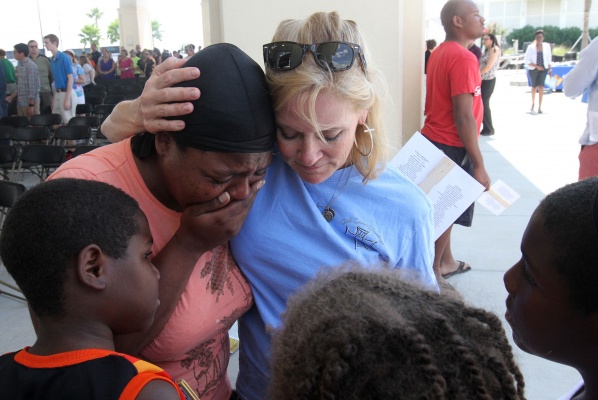Fordham Professor Discusses Post-Hurricane Katrina Coverage in New Book
TNS
Anne Warren of Gulfport, Miss., right, prays with April Moore of Gulfport after the 10 Years, 10,000 Reasons Hurricane Katrina remembrance service at Barksdale Pavilion in Jones Park in Gulfport on Saturday, Aug. 29, 2015. Moore, who said she lost everything in Katrina, was overcome by memories of the storm. (John Fitzhugh/Biloxi Sun Herald/TNS)
November 10, 2015
Robin Andersen, professor and director of both the Communication and Media Studies and Peace and Justice Studies departments at Fordham College Rose Hill (FCRH) gave a presentation about the media coverage during Hurricane Katrina at Fordham College Lincoln Center (FCLC) Law School. Her publication, entitled “HBO’s Treme and the Story of the Storm: From New Orleans as Disaster Myth to Ground Breaking Television,” will be published next year by Lexington Press.
The presentation, aptly given on the third anniversary (Oct. 29) of another humanitarian and environmental disaster, Superstorm Sandy, centered around all of the inaccuracies of journalists both during and following Hurricane Katrina and their detrimental effects for the community of New Orleans. Andersen argued that media coverage greatly affects our response to disasters. According to Andersen, the “media coverage contributed to suffering” during Hurricane Katrina.
Ten years ago, news outlets had a field day covering the devastation that hit New Orleans after Hurricane Katrina. One of the century’s most devastating disasters, Hurricane Katrina is estimated to have caused $108 billion in property damage and 1,833 known fatalities. With nearly 80 percent of the city sitting underwater, news coverage should have been focused on reporting on rescue efforts and the significant damage of the city. However, a different approach was taken. News outlets began to report on the supposed actions of the victims, with reputable news sources and journalists, like the New York Times’ Maureen Dowd, describing the city and the individuals left as “a snake pit of anarchy, death, looting, raping, marauding thugs.”
The reality of the situation in post-Katrina New Orleans, as Andersen reported, was quite the opposite. Now, it has been well documented that looting was way over emphasized. “The whole story was looting,” Andersen reported, causing a dramatic shift in the manner in which search and rescue efforts were handled. Andersen went on to explain that the “media coverage was so extreme in emphasizing the looting, search and rescue were taken off of the streets to protect property.” In a city with a population of approximately 455,00 in 2005, this drastic reduction of on the ground help greatly slowed the recovery process of the city and gave the world an inaccurate picture of what was truly happening in the city of New Orleans.
Andersen also discussed the rampant racial bias surrounding the media coverage. The areas hit hardest by the storm, like St. Bernard’s Parish and the Ninth Ward, are predominately African American communities. Andersen reported that they “were mistreated and portrayed as thugs.” While the white individuals that stayed were brave and “found” supplies, the African American population was wild⎼a group of thugs that stole and looted the community.
Ten years after the disaster, Andersen is still adamant about Hurricane Katrina’s relevancy and importance in the history of media coverage of humanitarian disasters. She argues that media coverage not only influences the opinions of its viewers, but also changes the course of action for the disaster. The manner in which Katrina was covered “is very important for the future of news media’s ability to cover disasters in a way that evokes empathy and compassion for its victims,” Andersen said.
When “Treme” premiered in 2010 on HBO, Andersen was happy to see a television series that portrayed the true happenings in post-Katrina New Orleans. The writing and filmography peaked Andersen’s interest initially, but the accuracy of the program as a whole is what kept Andersen watching. “Treme” follows a group of citizens from all walks of life as they attempt to rebuild their lives after Hurricane Katrina. While “Treme” is a fictional show, it based its characters off of real residents of New Orleans.
In order to fully portray New Orleans after the storm, David Simon and Eric Overmyer, the producers of the series, intended for “Treme” to run for five seasons. Due to low viewership, the program was cut after three and a half seasons in December 2013. While upsetting to Andersen, she believes that “Treme” will have a lasting effect on people and grow more recognizable as the years go on, much like Simon and Overmyer’s first series, “The Wire.”
In her forthcoming novel, Andersen uses “Treme” to critique the previous media coverage. In preparation for her book, Andersen visited the set in New Orleans several times to meet with the producers and conducted interviews with the television staff.
“Treme did something completely different; it disrupted and reinterpreted the story of the storm,” Andersen said. “Treme” humanizes the victims of Hurricane Katrina by telling their story in a first person point of view.
“I think [Hurricane Katrina] was the biggest humanitarian disaster that the United States ever had. How we covered that story is really important,” Andersen said. “The legacy of that kind of media coverage can last for a long time.”










